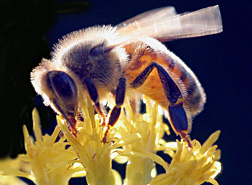
Ozone may make hives safer for honey bees by
breaking down pesticide residues and killing certain insect and disease pests.
Photo courtesy of David Cappaert, Michigan State University,
Bugwood.org.
|

|
Ozone Might Help Make Bee Hives Cleaner and Safer
By Marcia Wood
May 14, 2008 Ozone, which is already used to sanitize
drinking water and swimming pools, might help make hives cleaner and safer for
America's beleaguered honey bees. That's according to results from preliminary
laboratory tests by Agricultural Research Service (ARS) entomologist
Rosalind
R. James. She leads the agency's
Pollinating
Insects Biology, Management and Systematics Research Unit at Logan, Utah.
James tested ozone's effects on two pesticides, coumophos and
tau-fluvalinate, both widely used by beekeepers to control varroa mites, a
major enemy of bees. Studies elsewhere indicate that residues of these
chemicals can accumulate in hives, including in the honeycomb. Beekeepers
typically reuse the honeycomb after the honey has been extracted.
For the experiment, she placed glass vials of the pesticides in a small,
tightly sealed chamber, then exposed the chemicals to a flow of ozone gas.
Keeping the chamber at 50 percent relative humidity, she tested different
temperatures and different ozone and pesticide concentrations.
Applying 500 parts per million of ozone in an approximately 93 degree
Fahrenheit chamber for 10 to 15 hours degraded low concentrations of both
pesticides, but 20 hours were needed to break down higher concentrations of
tau-fluvalinate.
James also looked at ozone's ability to zap the greater wax moth, a
honeycomb pest, in all of its life stages, from egg to adult. Wax moths attack
bee young and damage the honeycomb.
Young wax moth larvae and adults were killed by just a few hours of ozone
exposure. However, eggs, the most resistant life stage, had to be exposed to
the gas for a few days.
Further tests are needed to find out whether the breakdown products of the
degraded pesticides pose a hazard to bees, James noted.
In related work, James is finding that ozone can destroy microbes that cause
major bee diseases such as chalkbrood and American foulbrood, but much higher
ozone concentrations and longer fumigation times are needed.
ARS, along with the National Honey Board,
headquartered in Firestone, Colo., and O3Co., Inc., of Idaho Falls, Idaho,
provided research support.
ARS is the U.S. Department of
Agriculture's chief scientific research agency.